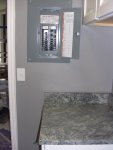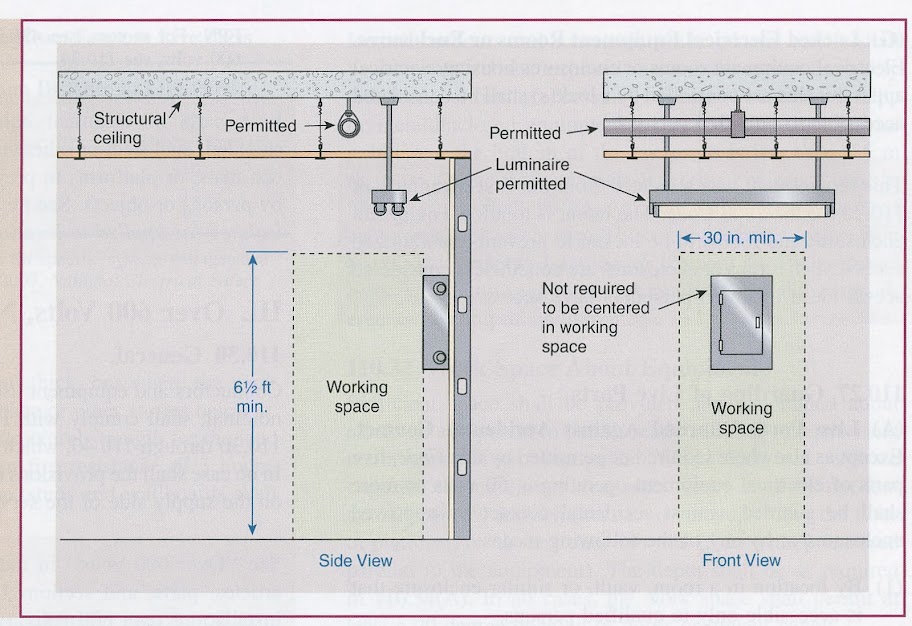Paul En
Member
- Location
- Temple Terrace, FL, USA
A 100-amp breaker in the main panel supplies the ?L-2? panel which serves the second level of the dwelling. It is this (Level 2) panel which is the focus of the Code question. The panel is located near the doorway of the laundry room. A base cabinet lies below a bit more than 50 percent of the width of the panel. There is no floor obstruction other than the base cabinet. The door of the panel opens more than 90 degrees.
The panel is quite accessible (?Readily Accessible?) pursuant to Definitions in Article 100 of the Code as well as the elaboration thereon in the Handbook.
The panel is labeled as shown in the picture with the identification of the panel and the location and number of the of the breaker in the main panel (located a few steps away on the same level) by which the panel may be de-energized. The label also states that the supply can be locked out at the fused disconnect on the outside of the building. Thus it is clearly demonstrated that it would NEVER ?likely to require examination, adjustment, servicing or maintenance while energized?.
Working space requirements are presented in 110.26(A)(1), (A)(2) and (A)(3) of the Code. Such requirements seem NOT to be applicable to this case as should be patently obvious from a careful reading of the passage. According to 110.26 (A), compliance with those tables is predicated on ?likely to require? that the equipment be worked hot. Further, the Handbook states explicitly in the second paragraph of the second shaded section on page 54 that ?Minimum working clearances are not required if the equipment is such that it is not likely to require examination, adjustment, servicing, or maintenance while energized.? (italics by writer)
The aforementioned Tables could not be applicable to a single family dwelling laundry room based on the context as well as the ?Conditions? noted in Table 110.26(A)(1). Each of the Conditions has as a part, ?Exposed live parts...? which should certainly never be the case in the the laundry room of a single family dwelling. Further, it is clear by the context in the explanatory material that reference is not being made to household sub panels but rather to massive switchgear and the like (see illustrations on page 55 of the Handbook).
That there is more than sufficient working space for the subject panel as well as it being readily accessible can be illustrated by the ease with which the electrical contractor replaced a damaged/defective AFCI breaker in the panel AFTER the base cabinet had been installed below it for some time.
Based on the information above and any other facts or citations you may choose from the Code or the Handbook,
Would you ?pass? or ?fail? the installation? If you would ?fail? the installation, what would be your basis (Code and/or Handbook citations would be greatly appreciated.)


The panel is quite accessible (?Readily Accessible?) pursuant to Definitions in Article 100 of the Code as well as the elaboration thereon in the Handbook.
The panel is labeled as shown in the picture with the identification of the panel and the location and number of the of the breaker in the main panel (located a few steps away on the same level) by which the panel may be de-energized. The label also states that the supply can be locked out at the fused disconnect on the outside of the building. Thus it is clearly demonstrated that it would NEVER ?likely to require examination, adjustment, servicing or maintenance while energized?.
Working space requirements are presented in 110.26(A)(1), (A)(2) and (A)(3) of the Code. Such requirements seem NOT to be applicable to this case as should be patently obvious from a careful reading of the passage. According to 110.26 (A), compliance with those tables is predicated on ?likely to require? that the equipment be worked hot. Further, the Handbook states explicitly in the second paragraph of the second shaded section on page 54 that ?Minimum working clearances are not required if the equipment is such that it is not likely to require examination, adjustment, servicing, or maintenance while energized.? (italics by writer)
The aforementioned Tables could not be applicable to a single family dwelling laundry room based on the context as well as the ?Conditions? noted in Table 110.26(A)(1). Each of the Conditions has as a part, ?Exposed live parts...? which should certainly never be the case in the the laundry room of a single family dwelling. Further, it is clear by the context in the explanatory material that reference is not being made to household sub panels but rather to massive switchgear and the like (see illustrations on page 55 of the Handbook).
That there is more than sufficient working space for the subject panel as well as it being readily accessible can be illustrated by the ease with which the electrical contractor replaced a damaged/defective AFCI breaker in the panel AFTER the base cabinet had been installed below it for some time.
Based on the information above and any other facts or citations you may choose from the Code or the Handbook,
Would you ?pass? or ?fail? the installation? If you would ?fail? the installation, what would be your basis (Code and/or Handbook citations would be greatly appreciated.)




